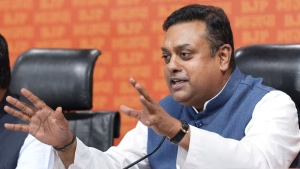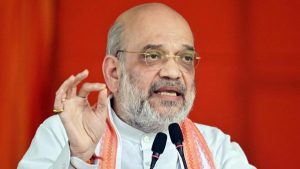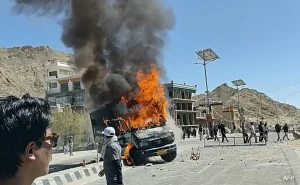Ladakh – The Union home ministry has directly attributed the recent Ladakh violence to activist Sonam Wangchuk’s “provocative statements” during his hunger strike, marking a significant escalation in the government’s response to the deadly protests. The ministry’s statement comes after four people died and 59 others were injured, including 22 police personnel, during violent demonstrations demanding full statehood for Ladakh on Wednesday.
The Ladakh violence descended into arson and street clashes in Leh, with protesters setting fire to government buildings and attacking security personnel. The Centre’s accusation against Wangchuk represents a sharp shift from previous diplomatic responses to the statehood movement, directly holding the environmental activist responsible for the chaos.
BJP Alleges Congress Conspiracy Behind Unrest

The Bharatiya Janata Party has made explosive allegations connecting the Ladakh violence to a broader Congress conspiracy aimed at destabilizing the region. BJP national spokesperson Sambit Patra claimed that the protests were not genuine “Gen Z” demonstrations but rather orchestrated Congress activities designed to create situations similar to those in Bangladesh, Nepal, and the Philippines.
Patra specifically named Congress councillor Stanzin Tsepang from Upper Leh ward as the “main instigator” of the Ladakh violence. The BJP spokesperson alleged that numerous photographs show Tsepang and his workers inciting violence, with video evidence showing him marching toward the BJP office with a weapon while instigating the mob.
The party has connected this alleged orchestration to what they claim is a broader plan involving Rahul Gandhi and George Soros to destabilize India through manufactured unrest when electoral success proves elusive.
Centre’s Detailed Account of Violence Escalation


The Union home ministry provided a comprehensive timeline of how the Ladakh violence unfolded, beginning with Wangchuk’s hunger strike that started on September 10. The government statement emphasized that despite ongoing dialogue through the High Powered Committee, “certain politically motivated individuals” were undermining the peace process.
According to the ministry, the Ladakh violence erupted when a mob, “motivated by provocative speeches,” left the hunger strike venue around 11:30 AM on September 24. The protesters attacked both political party offices and government buildings, including the Chief Executive Councillor’s office in Leh, before setting them ablaze and attacking security personnel.
The Centre noted the ironic timing of Wangchuk calling off his hunger strike amid the violence, suggesting this demonstrated his awareness of the consequences of his actions. The ministry stated that barring the initial violent incidents, the situation was brought under control by 4 PM.
Government’s Progress Claims and Dialogue Efforts
Despite the Ladakh violence, the Centre highlighted significant progress made through formal dialogue channels with the Apex Body Leh and Kargil Democratic Alliance. The government claimed “phenomenal results” through the High Powered Committee mechanism, including increasing Scheduled Tribe reservations from 45 percent to 84 percent and providing one-third women’s reservations in councils.
Additional achievements cited include declaring Bhoti and Purgi as official languages and commencing recruitment for 1,800 posts. The ministry emphasized that meetings were scheduled for September 25-26 with Ladakh leaders, followed by the next High Powered Committee meeting on October 6.
The government maintained that all demands related to Wangchuk’s hunger strike were integral parts of ongoing High Powered Committee discussions, questioning the necessity of the protests that led to the Ladakh violence.
Wangchuk’s Controversial Statements and References

The Centre specifically criticized Wangchuk’s references to “Arab Spring-style protests” and “Gen Z protests in Nepal” as deliberately inflammatory rhetoric that contributed to the Ladakh violence. The ministry argued that despite appeals from various leaders to end his hunger strike, Wangchuk continued his protest while making these provocative comparisons.
These references were particularly concerning to authorities as they appeared to encourage emulation of successful protest movements that had overthrown governments elsewhere. The timing of these statements, just before the violent escalation, strengthened the Centre’s argument about causation.
Political Counter-Narratives and Responses
Wangchuk responded to the allegations by arguing that Congress lacks sufficient influence in the region to mobilize thousands of protesters. This counter-argument challenges both the BJP’s conspiracy theory and indirectly addresses the Centre’s claims about political manipulation behind the Ladakh violence.
The activist’s response suggests that the violence stemmed from genuine local frustrations rather than external political orchestration, contradicting official government narratives about outside instigation.
Constitutional Commitments and Future Outlook


The Union home ministry reaffirmed the government’s commitment to Ladakh’s aspirations through “adequate constitutional safeguards,” while calling for restraint in circulating provocative content on social and traditional media platforms. This appeal reflects concerns about further escalation of the Ladakh violence through inflammatory content circulation.
The government’s statement balances acknowledgment of legitimate aspirations with firm condemnation of violent methods, setting the stage for continued dialogue while maintaining law and order priorities in the strategically important region.

